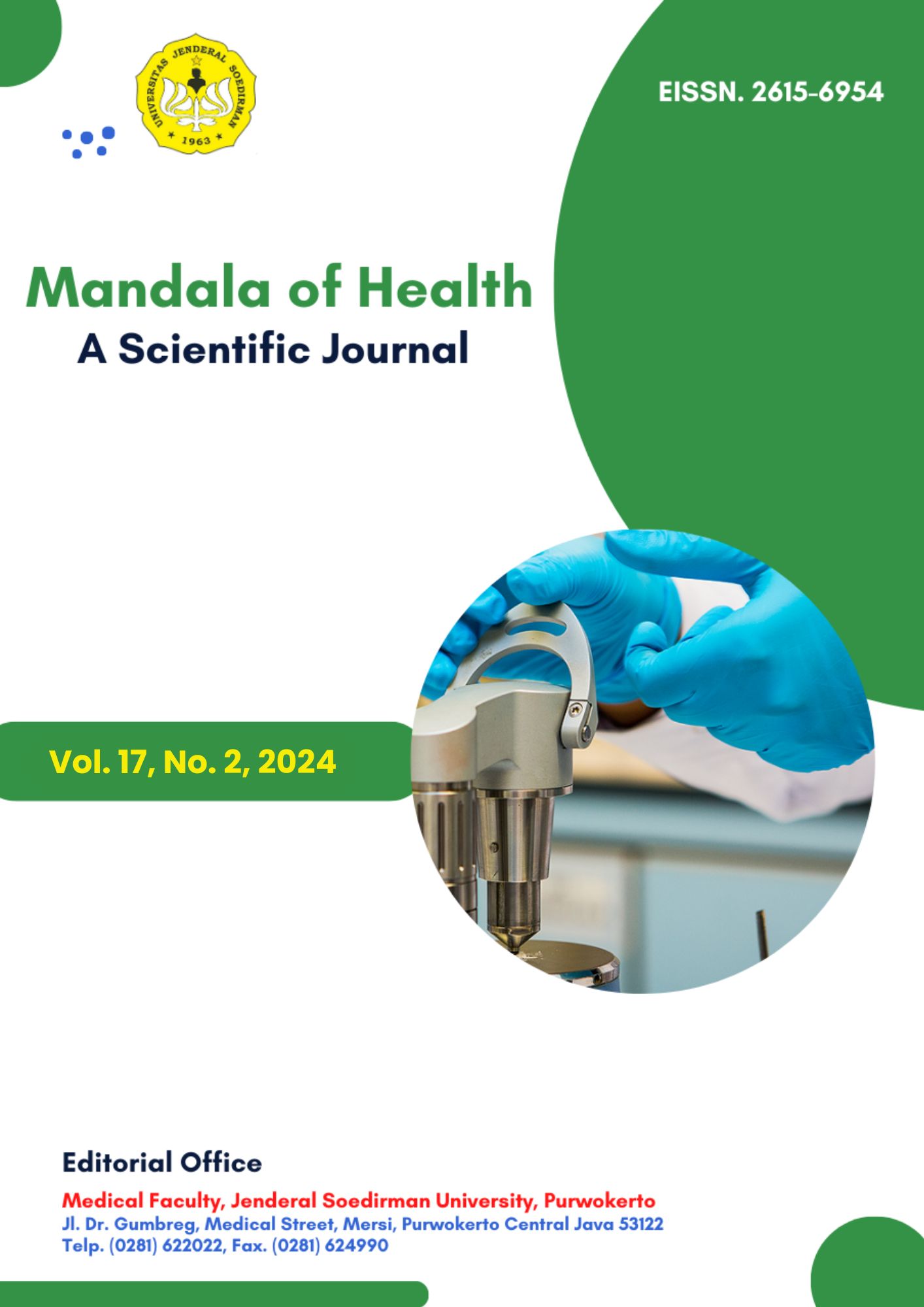MEAN URGE INCONTINENCE EPISODES COMPARISON AFTER SOLIFENACIN AND MIRABEGRON TREATMENT IN OVERACTIVE BLADDER PATIENTS: A CASE REPORT
Abstract
Latar Belakang: Overactive bladder (OAB) merupakan sindrom yang mengganggu kualitas hidup, khususnya kualitas hidup wanita. Pilihan terapi farmakologis untuk OAB adalah agen antimuskarinik (80%), seperti solifenacin. Agen agonis beta-3 juga merupakan pilihan terapi farmakologis baru untuk OAB, seperti mirabegron. Inkontinensia urin urgensi merupakan gejala OAB yang paling mengganggu, sehingga perlu dilakukan penilaian apakah solifenacin dan mirabegron memberikan perbaikan gejala yang berbeda. Kasus: Seorang wanita berusia 50 tahun dengan diagnosis overactive bladder (OAB) dengan gejala urgensi, frekuensi berkemih 20 kali/hari, nokturia 3 – 4 kali/malam, dan inkontinensia urgensi tanpa tanda-tanda peradangan saluran kemih. Pembahasan: Pencarian literatur dilakukan melalui Google Scholar, Pubmed, Embase, clinicaltrials.gov dan Cochrane library. Ditemukan total 532 artikel dengan hanya dua artikel meta analisis yang dicocokkan dan dinilai. Validitas, kepentingan dan penerapan meta-analisis dianalisis menggunakan tinjauan sistematik alat Oxford CEBM. Meta analisis menunjukkan bahwa solifenacin dan mirabegron tidak memiliki perbedaan yang signifikan dalam hal jumlah rata-rata episode inkontinensia urgensi. Kesimpulan: Solifenacin dan Mirabegron mempunyai pengaruh yang sama terhadap jumlah episode inkontinensia urgensi pada pasien OAB.
References
Aparasu, R. R., Sura, S., Earla, J. R., Shiozawa, A., Ng, D. B. & Schermer, C. R. (2020) Antimuscarinic Discontinuation in Patients with Overactive Bladder in Nursing Homes: A Retrospective Study of Medicare Beneficiaries. Advances in Therapy, 37, 3584-3605.
Batista, J. E., Kölbl, H., Herschorn, S., Rechberger, T., Cambronero, J., Halaska, M., Coppell, A., Kaper, M., Huang, M. & Siddiqui, E. (2015) The efficacy and safety of mirabegron compared with solifenacin in overactive bladder patients dissatisfied with previous antimuscarinic treatment due to lack of efficacy: results of a noninferiority, randomized, phase IIIb trial. Therapeutic advances in urology, 7(4), 167-179.
Chapple, C. R., Cardozo, L., Nitti, V. W., Siddiqui, E. & Michel, M. C. (2014) Mirabegron in overactive bladder: a review of efficacy, safety, and tolerability. Neurourology and urodynamics, 33(1), 17-30.
Chughtai, B., Forde, J. C., Buck, J., Asfaw, T., Lee, R., Te, A. E. & Kaplan, S. A. (2016) The concomitant use of fesoterodine and topical vaginal estrogen in the management of overactive bladder and sexual dysfunction in postmenopausal women. Post reproductive health, 22(1), 34-40.
D'Ancona, C., Haylen, B., Oelke, M., Abranches‐Monteiro, L., Arnold, E., Goldman, H., Hamid, R., Homma, Y., Marcelissen, T. & Rademakers, K. (2019) The International Continence Society (ICS) report on the terminology for adult male lower urinary tract and pelvic floor symptoms and dysfunction. Neurourology and urodynamics, 38(2), 433-477.
Gratzke, C., van Maanen, R., Chapple, C., Abrams, P., Herschorn, S., Robinson, D., Ridder, A., Stoelzel, M., Paireddy, A. & Yoon, S. J. (2018) Long-term safety and efficacy of mirabegron and solifenacin in combination compared with monotherapy in patients with overactive bladder: a randomised, multicentre phase 3 study (SYNERGY II). European urology, 74(4), 501-509.
Herschorn, S., Chapple, C. R., Abrams, P., Arlandis, S., Mitcheson, D., Lee, K. S., Ridder, A., Stoelzel, M., Paireddy, A. & van Maanen, R. (2017) Efficacy and safety of combinations of mirabegron and solifenacin compared with monotherapy and placebo in patients with overactive bladder (SYNERGY study). BJU international, 120(4), 562-575.
Hsu, F. C., Weeks, C. E., Selph, S. S., Blazina, I., Holmes, R. S. & McDonagh, M. S. (2019) Updating the evidence on drugs to treat overactive bladder: a systematic review. International urogynecology journal, 30, 1603-1617.
Johnston, K. M., Walker, D. R. & Lakzadeh, P. (2019) Characterizing the health-related quality of life burden of overactive bladder using disease-specific patient-reported outcome measures: a systematic literature review. Advances in therapy, 36, 548-562.
Kelleher, C., Hakimi, Z., Zur, R., Siddiqui, E., Maman, K., Aballéa, S., Nazir, J. & Chapple, C. (2018) Efficacy and tolerability of mirabegron compared with antimuscarinic monotherapy or combination therapies for overactive bladder: a systematic review and network meta-analysis. European urology, 74(3), 324-333.
Luo, D., Liu, L., Han, P., Wei, Q. & Shen, H. (2012) Solifenacin for overactive bladder: a systematic review and meta-analysis. International urogynecology journal, 23, 983-991.
Marcelissen, T., Rashid, T., Lopes, T. A., Delongchamps, N. B., Geavlete, B., Rieken, M., Cornu, J.-N. & Rahnama'i, M. S. (2019) Oral pharmacologic management of overactive bladder syndrome: Where do we stand? European Urology Focus, 5(6), 1112-1119.
Margulis, A. V., Linder, M., Arana, A., Pottegård, A., Berglind, I. A., Bui, C. L., Kristiansen, N. S., Bahmanyar, S., McQuay, L. J. & Atsma, W. J. (2018) Patterns of use of antimuscarinic drugs to treat overactive bladder in Denmark, Sweden, and the United Kingdom. PLoS One, 13(9), e0204456.
Milsom, I., Kaplan, S. A., Coyne, K. S., Sexton, C. C. & Kopp, Z. S. (2012) Effect of bothersome overactive bladder symptoms on health-related quality of life, anxiety, depression, and treatment seeking in the United States: results from EpiLUTS. Urology, 80(1), 90-96.
Minassian, V. A., Devore, E., Hagan, K. & Grodstein, F. (2013) Severity of urinary incontinence and effect on quality of life in women, by incontinence type. Obstetrics and gynecology, 121(5), 1083.
O Kane, M., Robinson, D., Cardozo, L., Wagg, A. & Abrams, P. (2022) Mirabegron in the Management of Overactive Bladder Syndrome. International Journal of Women's Health, 14, 1337 - 1350.
Vecchioli Scaldazza, C. & Morosetti, C. (2016) Comparison of therapeutic efficacy and urodynamic findings of solifenacin succinate versus mirabegron in women with overactive bladder syndrome: results of a randomized controlled study. Urologia Internationalis, 97(3), 325-329.
Wang, J., Zhou, Z., Cui, Y., Li, Y., Yuan, H., Gao, Z., Zhu, Z. & Wu, J. (2019) Meta‐analysis of the efficacy and safety of mirabegron and solifenacin monotherapy for overactive bladder. Neurourology and Urodynamics, 38(1), 22-30.
Wu, T., Duan, X., Cao, C.-X., Peng, C.-D., Bu, S.-Y. & Wang, K.-J. (2014) The role of mirabegron in overactive bladder: a systematic review and meta-analysis. Urologia internationalis, 93(3), 326-337.
Xu, Y., Farver, J. A. M. & Shin, Y. (2014) Shyness and psychosocial functioning in South Korean children. European Journal of Personality, 28(2), 147-155.

This work is licensed under a Creative Commons Attribution-NonCommercial-ShareAlike 4.0 International License.







